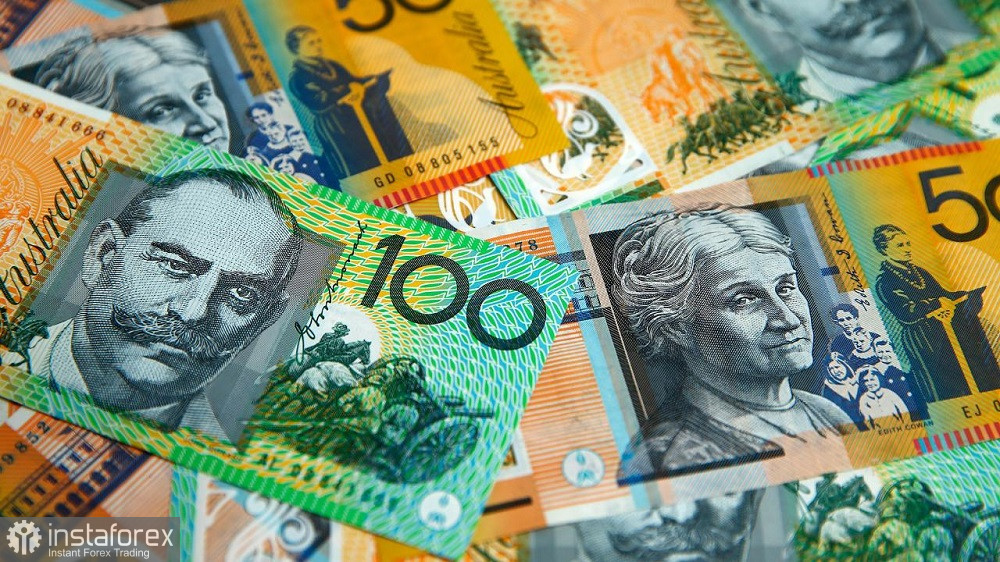The Australian dollar continues to slide down against the US currency. Notably, today the AUD/USD pair is declining even against the backdrop of a falling US dollar index. The minutes of the RBA's July meeting, published during Tuesday's Asian session, failed to provide support for the Aussie. The fundamental backdrop is currently not in favor of the Australian dollar, although the situation may change significantly in the medium term. However, the aussie/dollar pair is under pressure, despite the weak position of the greenback.
Chinese data and RBA minutes
Last Thursday, the pair reached a swing (nearly monthly) high, coming close to 0.6900. However, buyers did not have a chance to test this target as the US dollar regained strength following the release of consumer confidence data. The University of Michigan's consumer sentiment index unexpectedly entered the "green zone," rising to 72.6 compared to a forecast of 65.5. This is the strongest result since September 2021. The US currency seized on this positive news, allowing the AUD/USD bears to launch a downtrend, pushing the pair to 0.6800.

Adding fuel to the fire, data on China's economic growth was released. China's GDP in the second quarter of this year grew by 6.3% year-on-year, while the consensus forecast expected a growth rate of 7.3%. The Chinese economy was expected to show significant growth this year due to the low base effect. In April-May 2022, strict restrictive measures were imposed in several major cities in China, including Shanghai, one of the country's key economic regions. The strict lockdown essentially paralyzed the metropolis for nearly two months. However, even taking into account the low base effect, the second-quarter result fell by one percentage point below the projected growth rate. As China is one of Australia's main trading partners, these results weakened the buying positions of the AUD/USD pair.
Furthermore, today's released RBA minutes added pressure to the Aussie, although the document itself is quite contradictory and certainly does not have a "dovish" tone. Firstly, the board members agreed that "some further tightening" of monetary policy may be required in the near future, with this issue to be considered at the August meeting. Secondly, the central bank expressed concerns about inflation despite the recent positive inflation reports. The regulator noted that although domestic inflation has decreased, inflation in the service sector remains high, as well as rental prices, energy costs, and food prices. The central bank also highlighted the increase in the pro-inflationary indicator, as wages rose by 4% year-on-year in the third quarter.
In other words, the Reserve Bank of Australia left the door open for another interest rate hike, linking the August decision to the key macroeconomic indicators, particularly inflation and the labor market.
AUD/USD reaction
Judging by the reaction of AUD/USD traders, they focused on the cautious wording of the minutes, the rhetoric of which has a "conclusive character." For example, the document states that the board considered the possibility of keeping the rate unchanged or raising it by 25 basis points, but the arguments in favor of unchanged rates were more persuasive. RBA members also expressed concerns about the slowdown in economic growth, noting that the financial position of many households may worsen, and the unemployment rate "may rise more than necessary." The central bank stated that the pace of economic growth had significantly slowed, with GDP growth in the second quarter of this year reaching only 0.2% quarter-on-quarter.
Nevertheless, the main point of the published minutes is the potential interest rate hike at the August meeting. In this context, the key role will be played by the macroeconomic releases within the next 10 days. For example, on July 20, we will assess the employment data for Australia. The unemployment rate is expected to remain at 3.6%, with employment increasing by only 17,000. In addition, inflation reports will be published next week on July 26. We will find out the consumer price index for June and the second quarter of 2023. The inflation report will essentially determine the fate of the August meeting, considering the rhetoric of the July minutes from RBA members.
Conclusions
The AUD/USD pair is currently declining on rather fragile fundamental grounds. Therefore, short positions on the pair appear risky. If Australian non-farm data, not to mention the inflation report, show positive results, buyers will regain the initiative and return to 0.6900.
The same conclusion can be drawn from a technical standpoint. On the D1 time frame, the pair is positioned between the middle and upper lines of the Bollinger Bands indicator, as well as above all lines of the Ichimoku indicator, which shows a bullish Line Parade signal. In other words, the pair retains the potential for further growth, at least towards the first resistance level at 0.6900, the upper line of the Bollinger Bands indicator on the daily chart.
 English
English 
 Русский
Русский Bahasa Indonesia
Bahasa Indonesia Bahasa Malay
Bahasa Malay ไทย
ไทย Español
Español Deutsch
Deutsch Български
Български Français
Français Tiếng Việt
Tiếng Việt 中文
中文 বাংলা
বাংলা हिन्दी
हिन्दी Čeština
Čeština Українська
Українська Română
Română

